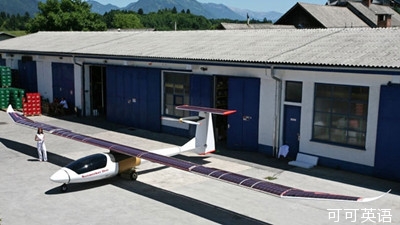科學(xué)技術(shù)
Solar-powered aircraft
太陽(yáng)能飛機(jī)
The Wright stuff?
萊特附體?
An enthusiastic inventor hopes to sell sun-powered planes
一位希望出售太陽(yáng)能飛機(jī)的癡狂發(fā)明家
THERE is something of the 19th century about Eric Raymond.
埃里克雷蒙和19世紀(jì)的人有點(diǎn)像。
Devoted to making commercial solar-powered aircraft, he would have thrived in the Victorian heyday of the private inventor.
這位致力于研發(fā)商用太陽(yáng)能飛機(jī)的發(fā)明家如果身在維多利亞私人發(fā)明家輩出的年代會(huì)很有一番成就的。
Most fell by the wayside; their ideas outran their ability or their money.
當(dāng)時(shí)很多發(fā)明者都半途而廢;他們的想法不是超出了其能力就是缺乏資金來(lái)達(dá)成。
 But the names of the successes—Morse, Dunlop, Bell, Diesel and even, to stretch the era into the early 20th century, the brothers Wright—have lived on.
But the names of the successes—Morse, Dunlop, Bell, Diesel and even, to stretch the era into the early 20th century, the brothers Wright—have lived on.
但是像莫斯,鄧祿普,貝爾,迪賽甚至是20世紀(jì)的萊特兄弟這些成功者的名字卻為后人所銘記。
Whether Mr Raymond will join their ranks remains to be seen.
雷蒙先生是否會(huì)身在名利還不得而知。
His latest effort, known as Sunseeker Duo, was taken out of its shed in June.
其最近的成果稱作追日者二人組號(hào),于6月成形。
It has yet to fly.
但還沒(méi)有進(jìn)行過(guò)飛行。
He has high hopes, however, that his solar plane soon will take to the air.
這架太陽(yáng)能飛機(jī)很快就能騰空而起,對(duì)此他抱有很高的期望。
Like its predecessor prototypes, Sunseeker I and Sunseeker II, Sunseeker Duo looks like what it is: a glider with a propeller and lots of solar cells to generate electricity on the upper surface of its wings.
和其前輩雛形機(jī)追日者一號(hào)和追日者二號(hào)一樣,追日者二人組號(hào)的外形就是一架配備了推進(jìn)器以及機(jī)翼面上裝有大量太陽(yáng)能發(fā)電電池的滑翔機(jī)。
The most obvious difference from the previous efforts are two seats in the cockpit.
與之前的作品相比,其最明顯的差異在于駕駛艙內(nèi)的雙人座椅。
That should make it easier to sell if Mr Raymond is ever able to go into full-scale production.
如果雷蒙先生能夠進(jìn)行全面投產(chǎn)的話,這一點(diǎn)可以促進(jìn)銷售。
There are lots of other differences, as well, though—ones that Mr Raymond hopes will bring the day of production closer.
其他差異也很多---雷蒙先生希望這些變化能夠使投產(chǎn)之日早日到來(lái)。
The Duo has a wingspan of 23 metres and a planned weight, when the main gear and any other missing equipment is on board, of 470kg.
二人組號(hào)翼展為23米,算上主傳動(dòng)裝置和其他未安裝的設(shè)備,計(jì)劃重量為470公斤。
A 20kW electric motor will drive the propeller, but all of those watts will be needed only during take off and climbing.
推進(jìn)器由一個(gè)20千瓦的電動(dòng)馬達(dá)驅(qū)動(dòng),但是這些動(dòng)力只在起飛和爬升時(shí)才用上。
In level flight, at an altitude of 6,000 metres, the 5kW provided by the solar panels will be enough both to drive the propeller and to recharge the batteries.
在海拔6000米的高度進(jìn)行水平飛行時(shí),太陽(yáng)能電板只需提供5千瓦的動(dòng)力便足夠驅(qū)動(dòng)推進(jìn)器以及給電池充電。
One big difference between the Duo and its predecessors is that those batteries are lithium-polymer cells sitting in the wings, near the plane's centre of gravity, and not nickel-cadmium ones scattered artfully around the airframe. Lithium-polymer cells are lighter.
二人組號(hào)與其前輩的一個(gè)很大的區(qū)別是位于機(jī)翼上靠近飛機(jī)重力中心位置的鋰聚合物電池,而不是巧妙地散布在機(jī)身周圍的鎳鎘電池。鋰聚合物電池重量更輕。
The system will also run at a higher voltage—300V, up from 200V in Sunseeker II—in order to reduce transmission losses along the six metres of cables that carry power to the motor at the back, just above the rudder.
二人組號(hào)的系統(tǒng)供電電壓也有提升,從追日者二號(hào)的200伏提升為300伏,以減少6米長(zhǎng)的輸電線向位于后方方向陀上方的馬達(dá)供電時(shí)的的傳輸損耗。
The Sunseeker project is still in many ways a sealing-wax-and-string operation.
在很多方面,追日者項(xiàng)目仍采取合作互助的模式。
The lithium-polymer batteries, for example, were donated by Tian Yu, a Chinese businessman with whom Mr Raymond is collaborating on a non-solar electric plane.
例如,所用的鋰聚合物電池是由一位叫做Tian Yu的中國(guó)商人捐贈(zèng)的,他與雷蒙先生正在就一架非太陽(yáng)能飛機(jī)項(xiàng)目進(jìn)行合作。
But one day, perhaps, the name of Raymond will be up there with the others.
但是,也許有那么一天,雷蒙將躋身名人之列。
For who in their right mind would have believed in 1902 that a couple of bicycle-makers from Dayton, Ohio, would achieve immortal fame the following year?
因?yàn)樵?902年,凡是心智正常之人,有誰(shuí)會(huì)想到來(lái)自俄亥俄州代頓市的一對(duì)生產(chǎn)自行車的兄弟盡能流芳百世呢?
 But the names of the successes—Morse, Dunlop, Bell, Diesel and even, to stretch the era into the early 20th century, the brothers Wright—have lived on.
But the names of the successes—Morse, Dunlop, Bell, Diesel and even, to stretch the era into the early 20th century, the brothers Wright—have lived on.
 But the names of the successes—Morse, Dunlop, Bell, Diesel and even, to stretch the era into the early 20th century, the brothers Wright—have lived on.
But the names of the successes—Morse, Dunlop, Bell, Diesel and even, to stretch the era into the early 20th century, the brothers Wright—have lived on.